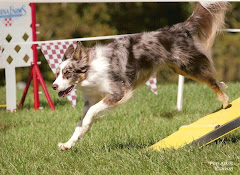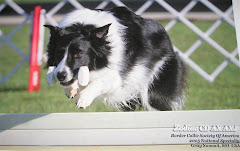Someone asked in a comment on my last post if Border Collies get hip dysplasia when they get older. I decided to write a post about this since the answer is not, shall we say, black and white (yes-pun intended).
First of all hip dysplasia is not something your dog gets, it's something your dog has. A perfectly sound young dog can be dysplastic. The term hip dysplasia simply refers to abnormal conformation of the hip joint, not necessarily the clinical signs of the disease. Generally speaking dogs are born with dysplastic joints-largely due to the breeding of poor genetic specimens (i.e. the parents had bad hips) and in some part due to bad luck. A normal hip joint fits like a ball and socket-the head of the femur should fit deep and smooth into the hip socket. In a dysplastic dog the socket is shallow and the head of the femur not perfectly round. There are varying degrees of severity but the outcome is an unstable joint-basically the hip is permanently partly out of joint.
Over time, the normal wear and tear on the joint causes secondary arthritic changes and increased discomfort associated with the joint. These changes can include thickening of the joint capsule, bony remodeling, and decreased range of motion.
An important point to note is that the clinical signs don't always correspond to the radiographic signs. In other words a dog with radiographically severe dysplasia might not limp much but a dog with mild dysplasia might limp a lot or start limping at a younger age. This is not always true but don't be fooled into thinking your dog is normal just because you have never seen it limp.
It's also important to recognize that arthritis doesn't just occur in conformationally abnormal joints. Arthritis or degenerative joint disease generally results from normal forces on abnormal joints or abnormal forces on normal joints. So a dog with all the genetic clearances in the world may ultimately develop painful degenerative disease when we subject them unnatural forces-this may be agility, frisbee or even the overweight lab who mostly sits around the house!
Hip dysplasia is more common in medium and large breed dogs just as luxating patellas are more common in small breed dogs. However it can occur in any size, breed, or mix and even in cats. Smaller dogs are less likely to show clinical signs because they don't carry as much weight around and in many cases are also not working dogs.
This is just a brief overview of hip dysplasia but hopefully it clears up some of the common misunderstandings. Maybe one of these days I'll write about treatment options too.
Summer
1 year ago


.jpg)
.jpg)



.jpg)



4 comments:
My last dog, a German Shepherd/Lab mix had hip dysplasia, towards her later years, it was really hard for her to walk and get up. That is actually one of the reasons we had her put down.
And my Aussie Bailey was diagnosed with HD when he was 6 months old. He started limping at around 5 months and took him to the vet and had x-rays done. He actually has it pretty severely. The vet said that we could either do surgery or wait til he was older when his muscles etc build up, which would help hold the hip joint. After a couple months, he quit limping. He doesn't limp at all, but I know he will show signs of it later on in his life.
Thanks for the very informative post!
THANKS for the answer. I have heard of bichons being injured because they jump and wondered about the causes etc.
My bichon loves to run and jump but then I had heard too much jumping wasn't good for them. I guess the more exercise the better unless they show signs of distress.
The PWDCA encourages everyone to have hips checked, especially if breeding is being considered. We've found that parents with excellent hips can produce a dysplastic pup and parents with borderline hips can produce excellent pups. It's a toss of the dice as to what a pup's hips will be. We can only test our breeding stock, then keep our fingers crossed.
My dog was diagnosed with HD a year and a half ago. Though I had a heath screening done when I adopted him nearly a year before then, the woman was scared the entire time and did a less than thorough job (should have went for a second screening after the very first visit).
I have a video linked to my blog (left hand menu under Sirius), which includes some of his recovery after surgery and how he is now.
Post a Comment